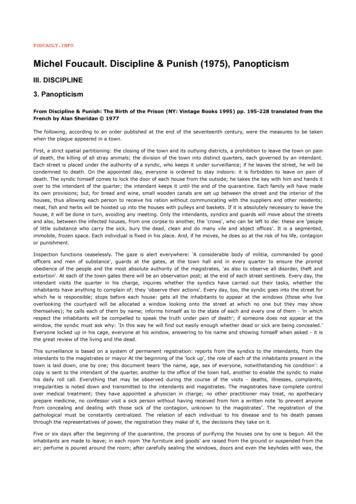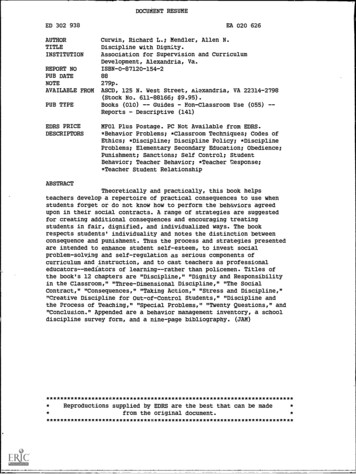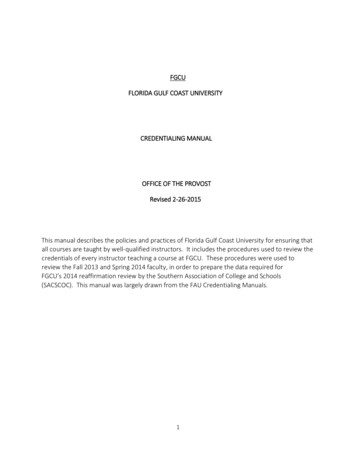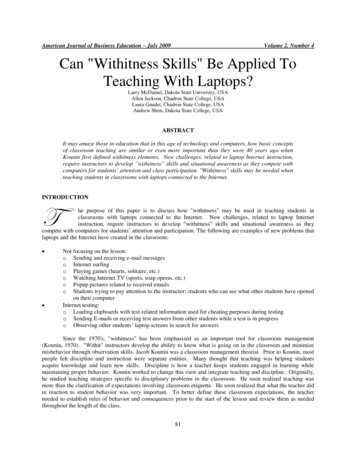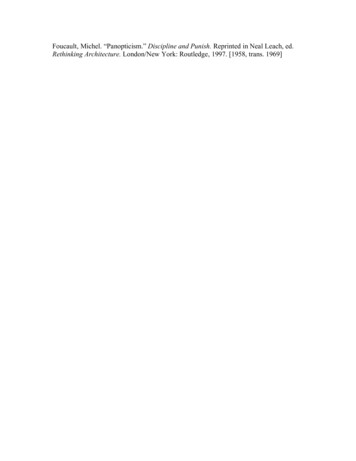
Transcription
Foucault, Michel. “Panopticism.” Discipline and Punish. Reprinted in Neal Leach, ed.Rethinking Architecture. London/New York: Routledge, 1997. [1958, trans. 1969]
POSTSTRUCTURALISM;)Foucaultdivision between the normal and the abnormal, to which every individual issubjected, brings us back to our own time, by applying the binary branding andexile of the leper to quite different objects; the existence of a whole set of tech niques and institutions for measuring, supervising and correcting the abnormalbrings into play the disciplinary mechanisms to which the fear of the plaguegave rise. All the mechanisms of power which, even today, are disposed aroundthe abnormal individual, to brand him and to alter him, are composed of thosetwo forms from which they distantly derive.Bentham's Panopticon is the architectural figure of this composition. Weknow the principle on which it was based: at the periphery an annular building;at the centre, a tower; this tower is pierced with wide windows that open ontothe inner side of the ring; the peripheric building is divided into cells, each ofwhich extends the whole width of the building; they have two windows, one onthe inside, corresponding to the windows of the tower; the other, on theoutside, aUows the light to cross the cell from one end to the other. All that isneeded, then, is to place a supervisor in the central tower and to shut up in eachcell a madman, a patient, a condemned man, a worker or a schoolboy. By theFigure 2 Bentham's Panopticon (1791)Source:J.Bentham, Panopticon; Postscript, London, 1791
·. oJ .ual isgandtech Jrffia]Ilague'oundthoseI. We[ding;omoeh ofneon the at iseach,y theeffect of backlighting, one can observe from the tower, standing our precisely Foucaultagainst the light, the small captive shadows in the cells of the periphery. Theyare like so many cages, so many small theatres, in which each actor is alone,perfectly individualized and constantly visible. The panoptic mechanismarranges spatial unities that make it possible to see constantly and to recognizeimmediately. In short, it reverses the principle of the dungeon; or rather of itsthree functions - to enclose, to deprive of light and to hide - it preserves onlythe first and eliminates the other two. Full lighting and the eye of a supervisorcapture better than darkness, which ultimately proteered. Visibiliry is a trap.To begin with, this made it possible - as a negative effect - to avoid thosecompact, swarming, howling masses that were to be found in places of confine ment, those painted by Goya or described by Howard. Each individual, in hisplace, is securely confined to a cell from which he is seen from the front by thesup ervisor; but the side walls prevent him from coming into contact with hiscompanions. He is seen but he does not see' he is the object of in rmation,never a subject In communication. T e arrangement of his room, opposite t ecentral (Ower, imposes on him an axial visibiliryj but the divisions of the ring,rhose separated cells, imply a lateral invisibility. And this invisibility is aguaranree of order. If the inmates are convicts, there is no danger of a plor, anattempr at collective escape, the planning of new crimes for the future, badreciprocal influences; if they are patients, there is no danger of contagionj ifthey are madmen, there is no risk of rheir committing violence upon oneanother; if they are schoolchildren, there is no copying, no noise, no charrer, nowaste of rime; if they are workers, there are no disorders, no theft, nocoalitions, none of those disrractions tnar slow down the rate of work, make itless perfect or cause accidents. The crowd, a compact mass, a locus of multipleexchanges, individualiries merging rogerher, a collective effeer, is abolished andreplaced by a collection of separated individualities. From the point of view ofthe guardian, it is replaced by a multiplicity that can be numbered and super vised; from the point of view of the inmates, by a sequestered and observedsolitude. 2Hence the major effecr of the Panopticon: to induce in the inmare a state ofconscious and ermanent visibili rhat assures rhe auromatic funcrionin ofpower. o ro arrange rhings that the surveil ance is permanent In irs effects, evenif ir is discontinuous in its acrion; tnat rhe perfection of power should tend torender irs acrua I exe rcise unnecessary; rhal th is a reh irectu ra I appara rus sho u Idbe a machine for crearing and sustaining a power relation independent of theperson who exercises it; in shorr, that the inmates should be caughr up in apower situation of which they are themselves the bearers. To achieve rhis, it isat once too much and roo little that rhe prisoner should be constantly observedby an inspector: roo little, for what matters is that he knows himself ro beobserved; too much, because he has no need in fact of being so. In view of this,Bentham laid down the principle that power should be visible and unverifiable.Visible: the inmate will constantly have before his eyes the tall outline of thecentral tower from which he is spied upon. Unverifiable: the inmate must neverknow whether he is being looked at at anyone moment; but he must be surethat he may always be so. In order to make the presence or absence of thein'spector unverifiable, so that tne prisoners, in rheir cells, cannot even see ashadow, Bentham envisaged not only venetian blinds on the windows of the.\.;,.:. .,
POSTSTRUCTURALISM362central observation hall, but, on the inside, partitions that intersected the hallat right angles and, in order to pass from one quarter to the other, not doors butzig-zag openings; for the slightest noise, a gleam of light, a brightness in a half opened door would betray the presence of the guardian. 3 The Panopticon is amachine for dissociating the see/being seen dyad: in the peripherrc ring, one istotally seen, without ever seeing; in the central tower, one sees everything with out ever being seen. 4It is an important mechanism, for it automatizes and disindjvidualizespower. Power has its principle not so much in a person as in a certain concerteddistribution of bodies, surfaces, lights, gazes; in an arrangement whose internalmechanisms produce the relation in which individuals are caught up. The,; ceremonies, the rituals, the marks by which the sovereign's surplus power wasmanifested are useless. There is a machinery that assures dissymmetry,disequilibrium, difference. Consequently, it does not matter who exercisespower. Any individual, taken a1J:nost at random, can operate the machine: inthe absence of the director, his family, his friends, his visitors, even hisservants. s Similarly, it does not matter what motive animates him: the curiosityof the indiscreet, the malice of a child, the thirst for knowledge of a philosopherwho wishes to visit this museum of human nature, or the perversity of thosewho take pleasure in spying and punishing. The more numerous those anony mous and temporary observers are, the greater the risk for the inmate of beingsurprised and the greater his anxious awareness of being observed. ThePanopticon is a marvellous machine which, whatever use one may wish to putit to, produces homogeneous effects of power.A real subjection is born mechanically from a fictitious relation. So it is notnecessary to use force to constrain the convict to good behaviour, the madmanto calm, the worker to work, the schoolboy to application, the patient to theobservation of the regulations. Bentham was surprised that panoptic institu tions could be so light: there were no more bars, no more chains, no moreheavy locks; all that was needed was that the separations should be clear andthe openings well arranged. The heaviness of the old 'houses of security' withtheir fortress-like architecture, could be replaced by the simple, economicgeometry of a 'house of certainty'. The efficiency of power, its constrainingforce have, in a sense, passed over to the other side - to the side of its surface ofapplication. He who is subjected to a field of visibility, and who knows it,assumes responsibility for the constraints of power; he makes them playspontaneously upon himself; he inscribes in himself the power relation in whichhe simultaneously plays both roles; he becomes the principle of his ownsubjection. By this very fact, the external power may throw off its physicalweight; it tends to the non-corporal; and, the more it approaches this limit, themore constant, profound and permanent are its effects: it is a perpetual victorythat avoids any physical confrontation and which is always decided in advance.Bentham does not say whether he was inspired, in his project, by Le Vaux'smenagerie at Versailles: the first menagerie in which the different elements arenot, as they traditionally were, distributed in a park. 6 At the centre was anoctagonal pavilion which, on the first floor, consisted of only a single room, theking's salon; on every side large windows looked out onto seven cages (theeighth side was reserved for the entrance), containing different species ofanimals. By Bentham's time, this menagerie had disappeared. But one finds inFoucaultP,tHoaDretHtHt
aU,alf I ut aish-layth erYr'srne,eIe)fthe programme of the Panopticon a similar concern with i divjd\1ali,?-ingobservation, with characterization and classification, with., the analyticalarrangement of space. The Panopticon is a royal menagerie; the animal isreplaced by man, individual distribution by specific grolJpmg and the king bythe machinery of a furtive power. With this exception, the Panopticon also doesthe work of a naturalist. It makes it possible to draw up differences: amongpatients, to observe the symptoms of each individual, without the proximity ofbeds, the circulation of miasmas, the effects of contagion confusing the clinicaltables; among schoolchildren, it makes it possible to observe performances(without there being any imitation or copying), to map aptitudes, to assesscharacters, to draw up rigorous classifications and, in relation to normaldevelopment, to distinguish 'laziness and stubbornness' from 'incurableimbecility'; among workers, it makes it possible to nOte the aptitudes of eachworke!, compare the time he takes to perform a task and, if they are paid by theday, to calculate their wages.?So much for the question of observation. But the Panopticon was also alaboratory; it could be used as a machine to carry out experiments, to alterbehaviour, to train or correct individuals. To experiment with medicines andmonitor their effects. To try out different punishments on prisoners, accordingto their crimes and character, and to seek the most effective ones. To teachdifferent techniques simultaneously to the workers, to decide which is the best.To tryout pedagogical experiments - and in particular to take up once againthe well-debated problem of secluded education, by using orphans. One wouldsee what would happen when, in their sixteenth or eighteenth year, they werepresented with other boys or girls; one could verify whether, as Helveriusthought, anyone could learn anything; one would follow 'the genealogy ofevery observable idea'; one could bring up different children according todifferent systems of thought, making certain children believe that two and twodo not make four or that the moon is a cheese, then put them together whenthey are twenty or twenty-five years old; one would then have discussions thatwould be worth a great deal more than the sermons or lecrures on which somuch money is spent; one would have at least an opportunitY of makingdiscoveries in the domain of metaphysics. The Panopticon is a privileged placefor experiments on men, and for analysing with complete certainty the trans formations that may be obtained from them. The Panopticon may even providean apparatus for supervising its own mechanisms. In this central tower, thedirector may spy on all the eroployees that he has under his orders: nurses,doctors, foremen, teachers, warders; he will be able to judge them con tinuously, aller their behaviour, impose upon them the methods he thinks best;and it will even be possible to observe the director himself. An inspectorarriving unexpectedly at the cenne of the Panopticon will be able to judge at aglance, without anything being concealed from him, how the entireestablishment is functioning. And, in any case, enclosed as he is in the middle ofthis architectural mechanism, is not the director's own fate entirely bound upwith it? The incompetent physician who has allowed contagion to spread, theincompetent prison governor or workshop manager will be the first vierims ofan epidemic or a revolt. "By every rie 1 could devise', said the master of thePanopticon, 'my own fate had been bound up by me with theirs" '.8 ThePanopticon functions as a kind of laboratory of power. Thanks to itsFoucault. .\ o. "
364POSTSTRUCTURALISMFoucaultmechanisms of observation, it gains in efficiency and in the ability to penetrateinto men's behaviour; knowledge follows the advances of power, discoveringnew objects of knowledge over all the surfaces on which power is exercised.The plague-stricken town, the panoptic establishment - the differences areimportant. They mark, at a distance of a century and a half, thetransformations of the disciplinary programme. In the first case, there is anexceptional situation: against an extraordinary evil, power is mobilized; itmakes itself everywhere present and visible; it invents new mechanisms; itseparates, it immobilizes, it partitions; it constructs for a time what is both acounter-city and the perfect society; it imposes an ideal functioning, but onethat is reduced, in the final analysis, like the evil that it combats, to a simpledualism of life and death: that which moves brings death, and one kiUs thatwhich moves. The Panopticon, on the other hand, must be understood as ageneralizable model of functioning; a way of defining power relations in termsof the everyday life of men. No doubt Bentham presents it as a particularinstitution, closed in upon itself. Utopias, perfectly closed in upon themselves,are common enough. As opposed to the ruined prisons, littered withmechanisms of torture, to be seen in Piranesi's engravings, the Panopticonpresents a cruel, ingenious cage. The fact that it should have given rise, even inour own time, to so many variations, projected or realized, is evidence of theimaginary intensity that it has possessed for almost two hundred years. But thePanopticon must not be understood as a dream building: it is the diagram of amechanism of power reduced to its ideal form; its functioning, abstracted fromany obstacle, resistance or friction, must be represented as a pure architecturaland optical system: it is in fact a figure of political technology that may andmust be detached from any specific use.It is polyvalent in its applications; it serves to reform prisoners, but also totreat patients, to instruct schoolchildren, to confine the insane, to superviseworkers, to put beggars and idlers to work. It is a type of location of bodies inspace, of distribution of individuals in relation to one another, of hierarchicalorganization, of disposition of centres and channels of power, of definition ofthe instruments and modes of intervention of power, which can be implementedin hospitals, workshops, schools, prisons. Whenever one is dealing with amultipli6ty of individuals on whom a task or a particular form of behaviourmust be imposed, the panoptic schema may be used. It is necessary.modifica tions apart - applicable 'to aU establishments whatsoever, in which, within aspace not too large to be covered or commanded by buildings, a number ofpersons are meant to be kept under inspection';9 (although Bentham takes thepenitentiary house as his prime example, it is because it has many differentfunctions to fulfil - safe custody, confinement, solitude, forced labour andinstruction).In each of its applications, it makes it possible to perfect the exercise ofpower. It does this in several ways: because it can reduce the number of thosewho exercise it, while increasing the number of those on whom it is exercised.Because it is possible to intervene at any moment and because the constantpressure acts even before the offences, mistakes or crimes have been committed.Because, in these conditions, its strength is that it never intervenes, it isexercised spontaneously and without noise, it constitutes a mechanism whoseeffects follow from one another. Because, without any physical instrument
TR UCTURALISMability to penetrate s of pOwer, discovering:h power is exercised. nt - the differences areury and a half, thee first case, there is anpower is mobilized; itts new. mechanisms', it. a time what is both aII functioning, hut one[ combats, to a simplearh, and one kills thatSt be understood as a'wer relations in terms nts it as a panicu/ar'd in upon themseJves'risons, Jittered With'ings, the Panopticonave given rise, even in d, is evidence of theundred years. But theit is the diagram of a'ing, abstracted from; a pore architecturalr JOgy that may and1 the f,soners, but also toinsane, ro superviseocation of bodies inther, of hierarchicaler, of definition of n f e implementedis dealing with aform of behaviourecessary modi fica in which, within a'ngs, a number ofBenrham takes the5 many differentarced labour andCt the exercise ofnumber of thosem if is exercised.use the constantbeen Committed.intervenes, it isechanism whosesical instrumentPANOPTICISMother than architecture and geometry, it acts directly on individuals; it gives Foucault'power of mind over mind'. The panoptic schema makes any apparatus ofpower more intense: it assures its economy (in material, in personnel, in time);it assures its efficacity by its preventative character, its continuous functioningand its automatic mechanisms. It is a way of obtaining from power 'in hithertounexampled quantity', 'a great and new instrument of governmem . ; itsgreat excellence consists in the great strength it is capable of giving to anyinstitution it may be thought proper to apply it to' .10It's a case of 'it's easy once you've thought of it' in the political sphere. It canin fact be integrated into any function (education, medical treatment, produc tion, punishment); it can increase the effect of this function, by being linkedclosely with it; it can constitute a mixed mechanism in which relations of power(and of knowledge) may be precisely adjusted, in the smallest detail, to theprocesses that are to be supervised; it can establish a direct proportion bet\veen'surplus power' and 'surplus production', ]n short, it arranges things in such away that the exercise of power is not added on from the outside, like a rigid" LJheavy constraim, to the functions it invests, but is so subtly present in them aV /to increase their efficiency by itself increasing its own points of contace. Thepanoptic mechanism is nor simply a hinge, a point of exchange between amechanism of power and a function; it is a way of making power relationsfunction in a function, and of making a function function through these powerrelations. Bentham's Preface to Panopticon opens with a list of the benefits tobe obtained from his 'inspection-house': 'Morals reformed - health preserved industry invigorated - instruction diffused - public burthens lightened Economy seated, as it were, upon a rock - the gordian knot of the Poor-Lawsnot cut, but untied - all by a simple idea in architecture!' ,IIFurthermore, the arrangement of this machine is such that its enclosednature does not ree a ermanent resence from the outside: we have seenthatone may come and exercise in t e central tower t e functions ofsurveillance, and that, this being the case, he can gain a clear idea of the way inwhich the surveillance is practised. In fact, any panoptic institution, even if it isas rigorously closed as a penitentiary, may without difficulty be subjected tosuch irregular and constant inspections: and not only by the appointedinspectors, but also by the public; any member of society will have the right tocome and see with his own eyes how the schools, hospitals, factories, prisonsfunction. There is no risk, therefore, that the increase of power created by thepanoptic machine may degenerate into tyranny; the disciplinary mechanismwill be democratically controlled, since it will be constantly accessible 'to thegreat tribunal committee of the world'.12 This Panopticon, subtly arranged sothat an observer may observe, at a glance, so many different individuals, alsoenables everyone to come and observe any of the observers. The seeing machinewas once a sort of dark room into which individuals spied; it has become atransparent building in which the exercise of power may be supervised bysociety as a whole.The panoptic schema, without disappearing as such or losing any of itsproperties, was destined to spread throughout the social body; its vocation wasto become a generalized function, The plague-stricken town provided anexceptional disciplinary model: perfect, but absolutely violent; to the diseasethat brought death, power opposed its perpetual threat of death; life inside it365
POSTSTRUCTURALISM366was reduced to its simplest expression; it was, against the power of death, themeticulous exercise of the right of the sword. The Panopticon, on the otherhand, has a role of amplification; although it arranges power, although it isintended to make it more economic and more effective, it does so not for poweritself, nor for the immediate salvation of a threatened society: its aim is tostrengthen the social forces to increase production, to develop the economy,spread education, raise the level of public morality; to increase and multiply.How is power to be strengthened in such a way that, far from impedingprogress, far from weighing upon it with its rules and regulations, it actuaUyfacilitates such progress? What intensificator of power will be able at the sametime to be a multiplicator of production? How will power, by increasing itsforces, be able to increase those of society instead of confiscating them orimpeding them? The Panopticon's solution to this problem is that theproductive increase of power can be assured only if, on the one hand, it can beexercised continuously in the very foundations of society, in the subtlestpossible way, and if, on the other hand, it functions outside these sudden,.-- vi olent, discontinuous forms that are bound up with the exercise ofsovereignty. The body of the king, with its strange material and physicalpresence, with the force that he himself deploys or transmits to some fewothers, is at the opposite extreme of this new physics of power represented bypanopticism; the domain of panopticism is, on the contrary, that whole lowerregion, that region of irregular bodies, with their details, their multiple move ments, their heterogeneous forces, their spatial relations; what are required aremechanisms that analyse distributions, gaps, series, combinations, and whichuse instruments that render visible, record, differentiate and compare: a physicsof a relational and multiple power, which has its maximum intensity not in theperson of the king, but in the bodies that can be individualized by theserelations. At the theoretical level, Bentham defines another way of analysingthe social body and the power relations that traverse it; in terms of practice, hedefines a procedure of subordination of bodies and forces that must increasethe utility of power while dispensing with the need for the prince. Panopticismis the general principle of a new 'political anatomy' whose object and end arenot the relations of sovereignty but the relations of discipline.The celebrated, transparent, circular cage, with its high tower, powerful andknowing, may have been for Bentham a project of a perfect disciplinaryinstitution; but he also set out to show how one may 'unlock' the disciplinesand get them to function in a diffused, multiple, polyvalent way throughout thewhole social body. These disciplines, which the classical age had elaborated inspecific, relatively enclosed places - barracks, schools, workshops - and whosetotal implementation had been imagined only at the limited and temporaryscale of a plague-stricken town, Bentham dreamt of transforming into a net work of mechanisms that would be everywhere and always alert, runningthrough society without interruption in space or in time. The panoptic arrange ment provides the formula for this generalization. It programmes, at the levelof an elementary and easily transferable mechanism, the basic functioning of asociety penetrated through and through with disciplinary mechanisms.There are two images, then, of discipline. At one extreme, the discip'line blockade, the enclosed institution, established on the edges of society, turnedinwards towards negative functions: arresting evil, breaking communications,Foucault
rURALlSMSPACE, KNOWLEDGE, POWER:r of death, theI, on the Otheralthough it is'not (or pOwer: its aim is to, the economy,lod multiply.rom impedingos, it actuallyIe at the sameincreasing itsIting them oris that theand, it can bethe su btlesthese sudden ,exercise of,lOd physicalro some fewsuspending time. At the other extreme, with panOptlCISm, is the disciplinemechanism: a functional mechanism that must improve the exercise of powerby making it lighter., more rapid, more effective, a design of subtle coercion fora society to come. The movement from one project to the other, from a schemaof exceptional discipline to one of a generalized surveillance, rests on ahistorical transformation: the gradual extension of the mechanisms of dis cipline throughout the seventeenth and eighteenth centuries, their spreadthroughout the whole social body, the formation of what might be called ingeneral the disciplinary society.NOTES234 resenced bywhole lower liple move required areand which e: a physicsIy not in theId by these( analysingpractice, he1St increaseanoplicismd end are5678910II12Archl ves mil ila ires de Vincen nes, A 1,516 91 sc. Piece. This regul3non is broadly similar 10 awhole Sene'S of others that dac" from the same period and earlier,J. Ikntham, Works, ed. Bowring, rv, 1843, pp. 60-4.In Ihe Ponoplicon; Postscript, 1791,lkmham adds dark insp 'ctlon go.lIerics painted in blackaround lhe inspL'Clor's lodge, each making it possible co observe lwO stories of cells.In his first version of .he Panopticon, Ikmham had also Imagined an acoU5cic surveillance,operall'd b)' means of pipes k-ad ing from Ihe cells 10 Ihe cemra I tower. In the Postscript heabandoned lhe idea, perha ps because he could not I ncroduce into itlhe principle of dissymetryand prevent Inc prisoners from hean ng Ihe inspector as well as Inc inspector hea ring lncm.Jul ius tril" l 10 devdop a syslem o( d issymelrical hSlening. (N. H. J uhus, LerollJ sur lesprisOns, I, 1831).Benlham, Works, p. 45.G. loisel, Histoire des Minogeri.s, 11. 1912, pp. 104-7.Bentham, \"(Iork s, pp. 60-4.Ibid., p. 177.Ibid., p. 40.Ibid. p. 66.Ib,d., p. 39.lmal(ming lhis conlinuous flow of visilOrs emering lhe cenlra) lOwer by an undergroundpa";3j;C and rhen observing Ihe circular landscape of che Panopricon, was Ikntham aware ofthe panoramas lhat Barker was produdng a I exactly lhe same period (lbe firsl seems 10 da tefrom 1787) and In which ehe visicors, occupying lhe cemral place,! :lw unfolding around thema landsc.ape, a cif)' or a banlc? The visilOrs occupied exa\:t1y the place of llle sovereign g3Z :.SPACE, KNOWLEDGE AND POWER (INTERVIEWCONDUCTED WITH PAUL RABINOW)werful andIsciplinary iscjplinesIghoul the)orated ind whosemporaryto a net runningarrange the levelning of aipline ,lurnedtcalions,PRIn your interview with geographers at Herodote, you said that architecturebecomes! political at the end of the eighteenth century. Obviously, it waspolitical in earlier periods, too, such as during the Roman Empire. What isparticular about the eighteenth century?MFMy statement was awkward in that form. Of course I did not mean to saythat architecture was not political before, becoming so only at that time. Ionly meant to say that in the eighteenth century one sees the developmentof reflection upon architecture as a function of the aims and techniques ofthe govemment of societies. One begins to see a form of political literaturethat addresses what the order of a society should be, what a city should be,given the requirements of the maintenance of order; given that one shouldavoid epidemiCS, avoid revolts, permit a decent and moral family [jfe, and367Foucault
Discipline and Punish. Reprinted in Neal Leach, ed. Rethinking Architecture. London/New York: Routledge, 1997. [1958, trans. 1969] POSTSTRUCTURALISM ;) Foucault division between

